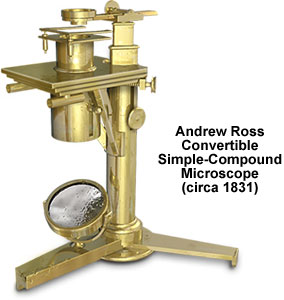Andrew Ross Convertible Simple-Compound Microscope
Andrew Ross fashioned the convertible, simple-compound microscope as a portable companion instrument to a full-sized brass compound microscope. Both were designed and commissioned in 1831 by William Valentine, a noted botanist from Nottingham, England.

The inspiration for the Valentine design may have come from Charles Gould, a British instrument maker who had designed a pocket version of the microscope that was portable enough for both the laboratory and routine botanical fieldwork. In fact, many nineteenth-century craftsmen imitated the original concept that Gould described in an 1827 publication. Nevertheless, the convertible simple-compound microscope is an early example of the fine craftsmanship of Ross, who created the instrument only a year after he established his telescope and microscope workshop in London.
Illustrated above in its simple form, the Ross instrument features a lens holder that may carry either a single lens or a Wollaston doublet. When the holder is removed, however, a compound body tube fits the single pillar stand. The instrument also consists of a substage condenser tube that includes an adjustment for the condenser lens and a large, concave mirror mounted on a brass gimbal that is attached to one leg of the Y-shaped microscope foot. A massive mechanical stage is fixed to the pillar stand and is capable of moving at right angles through the use of a pair of direct-acting screws. Later known as the Turrell mechanical stage, as a result of its description by William Turrell in an 1832 publication, the innovative design for controlling x-y translational motion with one knob is the basis for the modern mechanical stage. Flexible, but plagued with certain design flaws, several years later Ross created an improved version of the convertible instrument intended for use during dissections.
BACK TO NINETEENTH CENTURY MICROSCOPES
